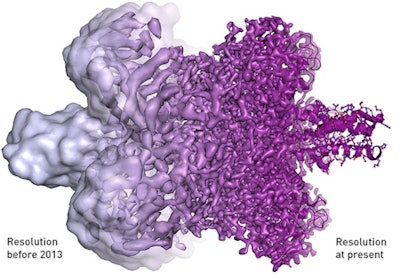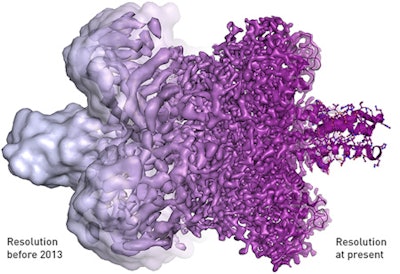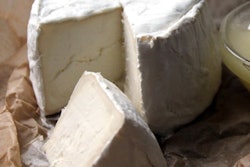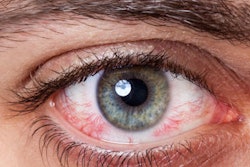
The Royal Swedish Academy of Sciences has awarded the Nobel Prize in chemistry 2017 to three researchers who developed cryo-electron microscopy to improve the imaging of biological molecules.
The recipients are the following:
- Jacques Dubochet, PhD, honorary professor of biophysics at University of Lausanne in Switzerland
- Joachim Frank, PhD, professor of biochemistry and molecular biophysics and of biological science at Columbia University in New York City
- Richard Henderson, PhD, molecular biologist and biophysicist with the MRC Laboratory of Molecular Biology in Cambridge, U.K.
With cryo-electron microscopy, researchers can freeze biomolecules in midmovement and visualize processes never seen before to advance the understanding of life's chemistry and to develop pharmaceuticals. All three researchers have made significant contributions to this field.
 Image illustrates how electron microscope resolution has improved in recent years from showing shapeless structures to visualizing proteins at atomic resolution. Illustration credit: Martin Högbom.
Image illustrates how electron microscope resolution has improved in recent years from showing shapeless structures to visualizing proteins at atomic resolution. Illustration credit: Martin Högbom.Between 1975 and 1986, Frank developed an image processing method in which the electron microscope's 2D images were analyzed and merged to create much sharper 3D structure.
In the 1980s, Dubochet rapidly cooled water so it solidified in its liquid form around a biological sample. The process allowed the biomolecules to retain their natural shape even in a vacuum.
Henderson followed in 1990 by using an electron microscope to generate a 3D image of a protein at atomic resolution. This breakthrough proved the technology's potential.
Today, researchers can routinely create 3D images of biomolecules to investigate everything from proteins that cause antibiotic resistance to the surface of the Zika virus.



















